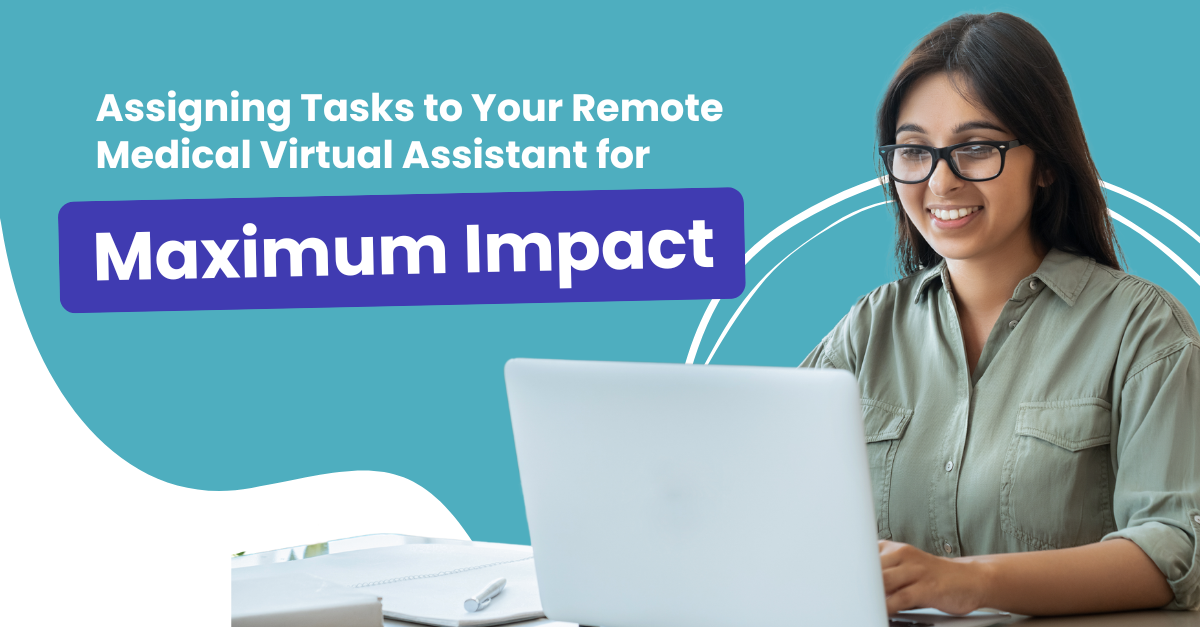 Healthcare providers are continually on the lookout for strategies to streamline their workflows, elevate patient care, and enhance overall efficiency. Hence, a transformative solution poised to revolutionize the operational landscape of healthcare practices is the remote virtual assistant. According to Business Research Insights, the market size of healthcare virtual assistants exceeded $692 million in 2021, with projections indicating a remarkable compound annual growth rate (CAGR) of 27.9% by 2031. This thus illuminates how the specialized skills of medical VAs have profoundly impacted practice productivity and patient outcomes. In this blog, we delve into the diverse array of tasks that can be effectively delegated to remote medical virtual assistants.
Healthcare providers are continually on the lookout for strategies to streamline their workflows, elevate patient care, and enhance overall efficiency. Hence, a transformative solution poised to revolutionize the operational landscape of healthcare practices is the remote virtual assistant. According to Business Research Insights, the market size of healthcare virtual assistants exceeded $692 million in 2021, with projections indicating a remarkable compound annual growth rate (CAGR) of 27.9% by 2031. This thus illuminates how the specialized skills of medical VAs have profoundly impacted practice productivity and patient outcomes. In this blog, we delve into the diverse array of tasks that can be effectively delegated to remote medical virtual assistants.
Common Tasks of a Remote Medical Virtual Assistant

Administrative Support
Medical virtual assistants undertake a wide range of administrative tasks vital for the efficient functioning of healthcare practices. Specifically, below are the administrative tasks medical virtual assistants can help healthcare providers with:
- appointment scheduling
- medical transcription
- billing and coding support
- medical record management
- patient communication
- insurance verification
- referral coordination
- data entry and documentation
- report generation
- inventory management
- correspondence management
- quality assurance
A remote medical virtual assistant must primarily have excellent organizational skills, attention to detail, and proficiency in healthcare-specific tasks to become an invaluable asset in optimizing workflow efficiency and enhancing overall practice performance.
Patient Communication and Engagement
Of course, as a remote medical virtual assistant, patient communication and engagement are paramount aspects of the role, involving effective interaction with patients to facilitate their healthcare experience. Therefore, tasks such as scheduling appointments, providing appointment reminders, following up on treatment plans, and addressing patient inquiries or concerns promptly and empathetically are on the line for them. Moreover, utilizing various communication channels such as phone, email, messaging platforms, or telehealth tools, virtual assistants ensure seamless communication with patients, fostering trust and confidence in the healthcare provider-patient relationship.
Data Management and Research
Furthermore, medical VAs can efficiently manage electronic health records (EHRs), update patient information, and ensure data accuracy and confidentiality. Medical virtual assistants also conduct literature reviews and research tasks to gather relevant medical literature, summarize findings, and provide insights to support evidence-based practice. By effectively managing data and conducting research, virtual assistants contribute to informed decision-making, regulatory compliance, and quality improvement initiatives within healthcare settings. Consequently, they enhance patient care delivery and practice efficiency.
Practice Optimization and Efficiency
As a remote medical virtual assistant, overseeing inventory management and performance reporting are integral responsibilities in optimizing healthcare practice operations. Therefore, the role entails tracking inventory levels of medical supplies and equipment, coordinating orders, and maintaining accurate records to ensure adequate stock availability. Additionally, virtual assistants generate performance reports, analyze practice metrics, and identify areas for improvement or optimization. Virtual assistants support healthcare providers in maintaining efficient supply chains, minimizing inventory costs, and enhancing overall practice productivity and performance. Consequently, through these efforts, virtual assistants contribute to streamlined operations, improved resource utilization, and ultimately, better patient care outcomes.
How to Assign Tasks to Your Remote Medical Virtual Assistant

Assigning tasks to your remote medical virtual assistant involves clear communication, delegation, and collaboration to ensure successful completion of assigned duties. To illustrate. here’s a step-by-step guide on how to effectively assign tasks to your virtual assistant.
Identify Tasks
Firstly, identify the specific tasks that you want to delegate to your remote medical virtual assistant. These tasks may include administrative duties, patient communication, data management, or any other tasks that support your practice operations.
Prioritize Tasks
Next, determine the priority of each task based on urgency, importance, and deadlines. Subsequently, rank tasks in order of priority to ensure that your medical virtual assistant focuses on the most critical tasks first.
Provide Clear Instructions
Furthermore, communicate the details and expectations for each task to your virtual assistant. Provide comprehensive instructions, including specific objectives, deadlines, and any relevant guidelines or protocols to follow.
Set Expectations
Next, clearly outline your expectations regarding task completion, quality standards, and communication protocols. Additionally, establish realistic timelines and milestones to track progress and ensure accountability.
Offer Training and Resources
If necessary, additionally provide training, resources, or access to tools and systems required to perform the assigned tasks effectively. Also, Offer guidance and support to help your medical virtual assistant familiarize the tasks and tools they’ll be using.
Encourage Feedback
Encourage open communication and feedback from your virtual assistant. Furthermore, allow them to ask questions, seek clarification, and provide input on task-related matters. This consequently fosters a supportive environment where collaboration and feedback can help improve task efficiency and outcomes.
Monitor Progress
Monitoring the progress of assigned tasks and checking in with your medical virtual assistant to ensure that they are on track are crucial. Therefore, use project management tools, communication platforms, or regular check-in meetings to track progress and address any issues or concerns promptly.
Provide Feedback
Also, provide constructive feedback and recognition for completed tasks. Acknowledge your virtual assistant’s efforts and achievements, and offer feedback to help them improve performance and grow in their role.
Maintain Communication
Finally, maintain regular communication with your virtual assistant to stay informed about task progress, address any challenges, and ensure alignment with practice goals and objectives. Consequently, you can effectively assign tasks to your remote medical virtual assistant and leverage their skills and expertise to optimize practice operations and enhance patient care delivery.
Conclusion
In conclusion, providing tasks to remote medical virtual assistants can have a transformative impact on healthcare practice operations and patient care delivery. By leveraging their expertise in administrative support, patient communication, data management, and practice optimization, healthcare providers after all can streamline workflows, enhance productivity, and focus their time and energy on delivering high-quality patient care.
Elevate your healthcare practice with seamless support from MedCore! Whether you’re seeking an expert remote medical virtual assistant or specialized services like medical coding, billing, or collections, MedCore has you covered. So, streamline your operations, boost efficiency, and enhance patient care with our dedicated team of professionals. Reach out to learn more about how MedCore can support your practice’s unique needs and objectives! Contact us here.

